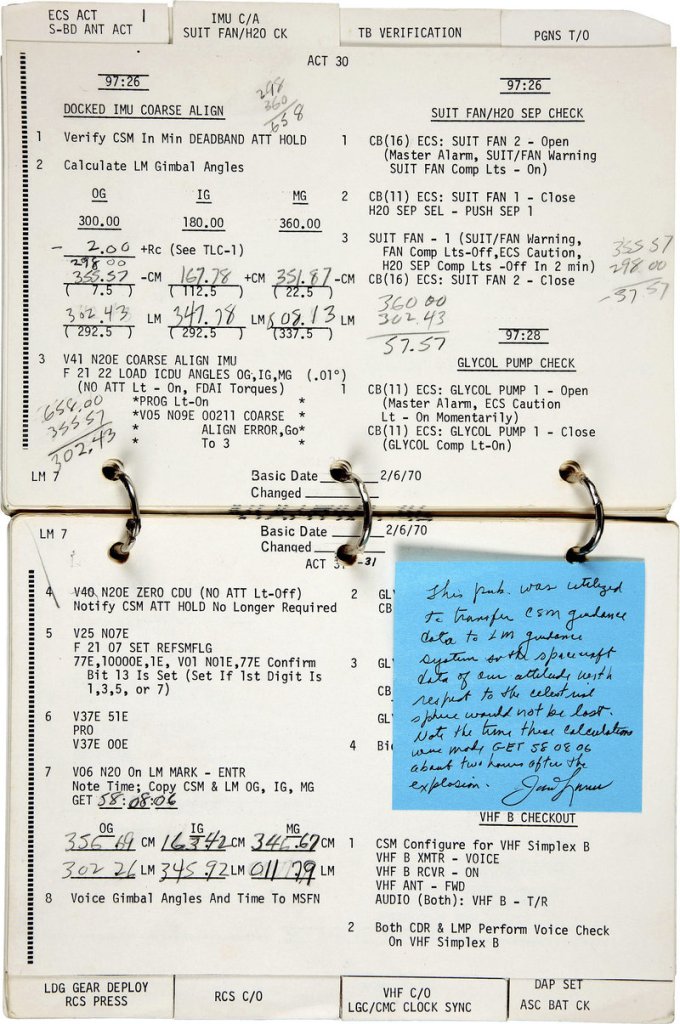More than 40 years ago, it was priceless.
The 70-page checklist — hastily updated after an in-space explosion — enabled the three astronauts aboard Apollo 13 to turn their lunar module into a lifeboat and survive what was nearly a deadly disaster.
So when officials at Heritage Auctions obtained the three-ring binder from the personal collection of Apollo 13 commander Jim Lovell, they expected it to fetch top dollar — but still were stunned by the final bid of nearly $390,000.
“That was an amazing price,” said Michael Riley, senior historian at the Dallas-based dealer.
And he said the sale, to an anonymous bidder, is emblematic of why space collectibles continue to do well even in tough economic times.
“It wasn’t just a space item. It was a human interest story,” Riley said.
Insiders estimate space collectibles — the real NASA stuff, not light sabers from that universe far, far away — account for as much as $10 million in sales annually. That’s expected to grow as artifacts from the space shuttle program — which ended last summer — hit the market.
“They say you don’t know what you have until it’s gone,” said Robert Pearlman, founder of the industry website collectSPACE and widely considered a guru on space memorabilia.
“And with the end of the shuttle program, people are starting to recognize the (collectible value) of the shuttle program, and it’s reminding them of the early programs, like Apollo. We’re seeing increased interest across the board,” he said.
Among the newer trends: trying to collect an item from each of the 133 successful shuttle missions, such as one of the thousands of miniature American flags, coins and other trinkets carried on every launch.
“It would be very hard, if not impossible,” said Riley, who estimated just one flag would cost $100, with the price increasing to $500 or more for noteworthy missions such as the first one.
It’s just one example of the wide range of space artifacts on sale that include everything from patches and flight suits to pens and engine parts.
Adding to their value — and the cachet — is the hazy legality of selling NASA artifacts.
Just a few months before the Apollo 13 checklist went to auction, NASA pressed the Justice Department to sue former Apollo 14 astronaut Edgar Mitchell for trying to sell a 16 mm camera he took to the moon. Mitchell ultimately gave up but told The Palm Beach Post he did so only because fighting the government was too time-consuming and expensive.
“Frankly, none of us former Apollo astronauts understand it at all,” Mitchell said.
Investigators at NASA’s Office of Inspector General, who monitor illicit sales of NASA goods, noted in a report that the camera was worth $60,000 to $80,000.
It wasn’t the first time NASA has pursued legal action against those trying to sell agency artifacts.
Earlier this year, NASA helped Florida authorities arrest a former contractor accused of stealing shuttle tiles and selling them on eBay.
It also stopped the sale of employee badges issued to the three Apollo 1 astronauts who died in a launchpad fire in 1967. A former Kennedy Space Center security official had hidden them for 44 years.
“An auction house valued the set of badges at $20,000 to $30,000,” noted one NASA report.
In all, NASA’s inspector general has investigated 127 cases of property theft, resulting in 36 convictions. The recent retirement of the space shuttle could mean more of these cases.
One government report estimated that NASA had about 1.2 million items of shuttle property worth more than $12 billion. But it’s up to the agency to decide what it wants to sell.
NASA regulations on the sale of artifacts are much stricter than in the agency’s early years.
During the initial Apollo missions, astronauts were given broad leeway to keep souvenirs from their missions, which led to Lovell’s taking the checklist and Mitchell the camera.
Nowadays, astronauts are allowed to keep only the clothes they wore, their personal-hygiene kits and any food they didn’t eat, Pearlman said.
Items such as the miniature American flags or commemorative coins that flew aboard missions were given out as gifts or awards, and many have found their way into the market. But Pearlman said “NASA has held tight rein on shuttle artifacts.”
Still, some NASA items are for sale by the government.
NASA turns over aging or obsolete equipment it doesn’t want to the General Services Administration, a federal agency that runs an online auction. This month the GSA was selling communications equipment from Goddard Space Flight Center for $35, although a description did not indicate whether the gear flew in space.
Send questions/comments to the editors.



Success. Please wait for the page to reload. If the page does not reload within 5 seconds, please refresh the page.
Enter your email and password to access comments.
Hi, to comment on stories you must . This profile is in addition to your subscription and website login.
Already have a commenting profile? .
Invalid username/password.
Please check your email to confirm and complete your registration.
Only subscribers are eligible to post comments. Please subscribe or login first for digital access. Here’s why.
Use the form below to reset your password. When you've submitted your account email, we will send an email with a reset code.